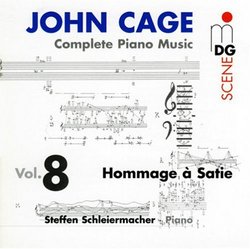| All Artists: John [1] Cage, Steffen Schleiermacher Title: John Cage: Complete Piano Music, Vol. 8 (Hommage à Satie) Members Wishing: 1 Total Copies: 0 Label: MD&G Records Release Date: 4/23/2002 Genres: Dance & Electronic, International Music, Classical Styles: Latin Music, Tango, Chamber Music, Forms & Genres, Short Forms, Historical Periods, Classical (c.1770-1830), Instruments, Keyboard Number of Discs: 1 SwapaCD Credits: 1 UPC: 760623079424 |
Search - John [1] Cage, Steffen Schleiermacher :: John Cage: Complete Piano Music, Vol. 8 (Hommage à Satie)
 | John [1] Cage, Steffen Schleiermacher John Cage: Complete Piano Music, Vol. 8 (Hommage à Satie) Genres: Dance & Electronic, International Music, Classical
|
Larger Image |
CD Details |
CD ReviewsSatie's influence is never direct,in between the lines scarecrow | Chicago, Illinois United States | 01/27/2005 (5 out of 5 stars) "Satie's influence on contemporary music was far-reaching numerous and transcendant. This reach never obvious or grandiose was through his work,his recluse life as a salon pianist and his music its exquisite,elegantly proportioned piano music He brought a conceptual fluidity,of idea, shape,and design with level of aesthetic subversion. His work always implied much more than the surfaces it produced.His music is always lyrical, captivating, haunted by something, some timeless unknown, parts of his life we may never know.He died in the late Twenties with an apartment hardly known by anyone then entered for years seeing a mound of music manuscript.
Transitionally Debussy and the French(Milhaud, Poulenc, Auric,Honegger. . . )found open pathways with Satie, this simplicity of concept, of approach to making art all within the mileau of Wagnerian domination within music's realms,opera at the transitional points. Satie (within this context)until today remains a "freedom" of sorts. He thought that music should be more than what it thinks it is, and we should finally take Beethoven,the transcendant, apocalyptic, elitist, bourgeous materials off one's writing desk. The eternal Sonata or the transcendant narrative(as German opera) is not worth pondering,when modernist innovation is there of structure and concept waiting for discovery. Satie's free conceptual fluidity,was the birth of modernity for music for as the early"Sarabandes"and "Nocturnes" it was music no one could comprehend,no threads to follow. These were points for composers and artists to follow. Satie's "Vexations" for instance a 9 hour work,is a simple two line fragement piece for piano solo, to be played incessantly hundreds of times,He was also the first to accompany film live "Ent'racte".He could make music for anything and anyone.The musical miniature is his device anti-romantic in content.(Sports et divertissements) When we come to John Cage,the post-war now you virtually have identical paradigms at work,wars seem to always create ideological beginning points,or points of renewal in art.So now the post-modern,the loss of certainty(Adorno's enigmatic canon) the search now for greater points of accesibility.Cage's creativity sought refuge in the concept,where modern dance welcomed it, and performance art. Much of this music here on these CDs was written for The Merce Cunningham Dance Company,and works quite well, in that the simplicity of timbres makes for wonderful un-accompaniment,screens for modern dance."Dream" here is disarming in beauty, G-minor mode quite a thrill to dance to this harmonic blends,sustain pedal down throughout. Likewise I don't think Satie would have preferred to re-do a Toy Piano work for its parent large piano, it is something very different, more authoritarian. Must have been a lapse of concept for Cage."Perpetual Tango" takes you into the dance hall here a quiet one, subdued.Again Cage learned the beuty of economy from Satie, less is indeed more than enough. All the music on this disk is quite beautiful, disarming,yet you sense the smell of the greasepaint,the theatre. Cage came to think of Satie as a free reservoir to visit now and again in substitution, as :Cheap Imitation: where he alters notes from Satie's original, something composers today in 2005 still practice.Yet again the simplicity is one to devote one;s life to. The British also found fertile ground in Satie, Howard Skempton and John White." |

 Track Listings (13) - Disc #1
Track Listings (13) - Disc #1